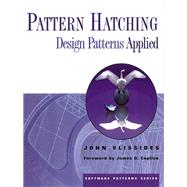
Note: Supplemental materials are not guaranteed with Rental or Used book purchases.
Purchase Benefits
What is included with this book?
John Vlissides is a member of the research staff at the IBM T. J. Watson Research Center in Hawthorne, New York. He has practiced object-oriented technology for more than a decade as a designer, implementer, researcher, lecturer, and consultant. In addition to co-authoring Design Patterns: Elements of Reusable Object-Oriented Software, he is co-editor of the book Pattern Languages of Program Design 2 (both from Addison-Wesley). He and the other co-authors of Design Patterns are recipients of the 1998 Dr. Dobb's Journal Excellence in Programming Award.
| Foreword | ix | (4) | |||
| Preface | xiii | ||||
|
1 | (12) | |||
|
3 | (7) | |||
|
10 | (3) | |||
|
13 | (48) | |||
|
14 | (4) | |||
|
18 | (6) | |||
|
24 | (5) | |||
|
29 | (8) | |||
|
37 | (1) | |||
|
38 | (7) | |||
|
45 | (13) | |||
|
58 | (3) | |||
|
61 | (62) | |||
|
61 | (11) | |||
|
72 | (7) | |||
|
79 | (6) | |||
|
85 | (17) | |||
|
102 | (8) | |||
|
110 | (4) | |||
|
114 | (9) | |||
|
123 | (22) | |||
|
145 | (8) | |||
|
146 | (1) | |||
|
147 | (1) | |||
|
148 | (1) | |||
|
149 | (1) | |||
|
150 | (1) | |||
|
151 | (1) | |||
|
151 | (1) | |||
|
152 | (1) | |||
| Bibliography | 153 | (4) | |||
| Index | 157 |
The New copy of this book will include any supplemental materials advertised. Please check the title of the book to determine if it should include any access cards, study guides, lab manuals, CDs, etc.
The Used, Rental and eBook copies of this book are not guaranteed to include any supplemental materials. Typically, only the book itself is included. This is true even if the title states it includes any access cards, study guides, lab manuals, CDs, etc.